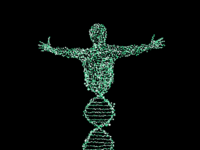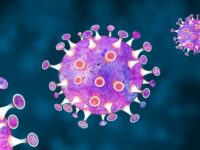DNA is the genetic information in each of our cells that encodes specific genes and characteristics. Although this source of genetic information seems like something that should be stable and unchanging, it can be influenced by the randomness of physics phenomena, and these resulting genetic changes can drive evolution. Spontaneous genetic mutations, potentially explained by quantum tunneling, can change the sequence of DNA and greatly impact an organism or even an entire population of organisms.
“Although this sources of genetic information seems like something that should be stable and unchanging, it can be influenced by the randomness of physics phenomena, and these resulting genetic changes can drive evolution.”
To better understand the molecule, DNA is made of nitrogenous base pairs that fit together like puzzle pieces to create a double helix structure. If DNA’s double helix structure is thought of as a twisted ladder, the paired nitrogenous bases make up the rungs of the ladder, held together with hydrogen bonds. Hydrogen bonding between base pairs provides stability to the DNA molecule while also allowing it to be “unzipped” for replication and translation. These base pairs — adenine, cytosine, thymine, and guanine — only slightly differ from each other, but changes in just one pair can make a huge impact on the gene that it is a part of. DNA is susceptible to these mutations, or changes in its sequence of nitrogenous bases.
Quantum tunneling is a physical phenomenon that can occur anywhere, including inside our bodies on a molecular level. It is characterized by the chance of finding a subatomic particle somewhere it is not supposed to be; though very unlikely, the possibility is never zero. For genetic mutations, hydrogen atom protons can “tunnel” from one side of a barrier — in this case, the hydrogen bonds between base pairs — to the other.
This quantum tunneling may cause spontaneous mutations to arise in our DNA. Normally, adenine (A) pairs with thymine (T), and guanine (G) pairs with cytosine (C). However, when proton tunneling occurs, an A-T base pair might turn into an A-G or C-T base pair because of the displacement of a hydrogen atom, as Slocombe et al. write in their 2021 paper published in Physical Chemistry Chemical Physics. This change in base pairs changes the sequence of the DNA, updates the protein that it might encode, and may even result in a different phenotypic trait from what the original gene encoded. Needless to say, just a few mutations can have enormous impacts on the organism inside which they originate.
“This change in base pairs ranges the sequence of the DNA, updates the protein that it might encode, and may even result in a different phenotypic trait from what the original gene encoded.”
As an example of quantum tunneling’s widespread consequences, mutations are the prime driver of natural selection because mutations in germline cells can be passed onto an organism’s offspring. Mutations conferring higher survival rates are selected for within a population over time. Likewise, unfavorable mutations are selected against. Eventually, new, favorable mutations become more common in a population, and unfavorable mutations disappear, leading to a species’s evolution. Though mutations originate from a phenomenon that happens at the subatomic level, the result modifies a structure so essential to our biology that it can shape the future of a species.
Sources: 1






